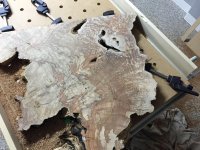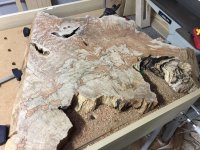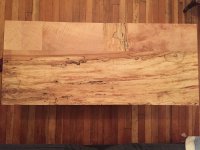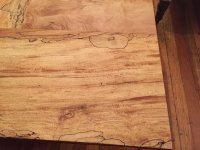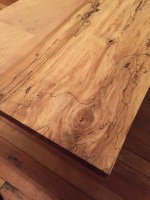Toolinator
Member
- Joined
- Dec 22, 2014
- Messages
- 48
I picked up a small piece of maple that has spalting in it to make into a small coffee table. I planned the top with a router sled and sanded the top way up 800 grit. I have a few questions for you guys...
- Chalk colored wood: in the pics you can see that a decent chunk of the top doesn't look like normal maple, it looks sort of chalk-like particularly the right side of the attached photo (and it's not soft, feels hard if you knock it). Some of the edge was rotten and crumbled and I am assuming this is connected? Is this going to look odd when finished?
- Chip out: I used a brand new 2" straight bit that I thought would be perfect for planning. But there are some small bits here and there of the surface that pulled out. I took two passes at clearing maybe 1/8" at a time. Would a round bowl bit be better?
- the live edge is very contoured and rough (partially from using a soft metal spinning brush to remove the softer rotten wood from the remaining hard maple). What is the best way to smooth the contours a bit? Files/rasps seem like they would take quite awhile, and grinder "flap disks" at a higher grit still seem aggressive.
Any thoughts here? Thanks guys!
- Chalk colored wood: in the pics you can see that a decent chunk of the top doesn't look like normal maple, it looks sort of chalk-like particularly the right side of the attached photo (and it's not soft, feels hard if you knock it). Some of the edge was rotten and crumbled and I am assuming this is connected? Is this going to look odd when finished?
- Chip out: I used a brand new 2" straight bit that I thought would be perfect for planning. But there are some small bits here and there of the surface that pulled out. I took two passes at clearing maybe 1/8" at a time. Would a round bowl bit be better?
- the live edge is very contoured and rough (partially from using a soft metal spinning brush to remove the softer rotten wood from the remaining hard maple). What is the best way to smooth the contours a bit? Files/rasps seem like they would take quite awhile, and grinder "flap disks" at a higher grit still seem aggressive.
Any thoughts here? Thanks guys!

